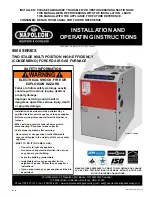
6
Furnace
Water
Heater
Opening
Chimney or Gas Vent
NOTE: The single opening must have
a free area of not less than one
square inch per 3000 BTU of
the total input rating of all equip-
ment in the enclosure, but not less than
the sum of the areas of all vent
connectors in the confined space.
Alternate
Opening
Location
Figure 5
Equipment Located in Confined Spaces; All
Air from Outdoors - Single Air Opening. See
5.3.3-b.
5. When directly communicating with the outdoors, the single
opening shall have a minimum free area of 1 square inch per
3,000 BTU per hour of total input rating of all equipment in
the enclosure
5.3.4 Specially Engineered Installations:
The requirements of 5.3.3 shall not necessarily govern when special
engineering, approved by the authority having jurisdiction, pro-
vides an adequate supply of air for combustion, ventilation, and
dilution of flue gases.
5.3.5 Louvers and Grilles:
In calculating free area in 5.3.3, consideration shall be given to the
blocking effect of louvers, grilles or screens protecting openings.
Screens used shall not be smaller than 1/4 inch mesh. If the area
through a design of louver or grille is known, it should be used in
calculating the size of opening required to provide the free area
specified. If the design and free area is not known, it may be
assumed that wood louvers will have 20-25 percent free area and
metal louvers and grilles will have 60-75 percent free area. Louvers
and grilles shall be fixed in the open position or interlocked with the
equipment so that they are opened automatically during equipment
operation.
5.3.6 Special Conditions Created by Mechanical Exhausting or
Fireplaces:
Operation of exhaust fans, ventilation systems, clothes dryers, or
fireplaces may create conditions requiring special attention to avoid
unsatisfactory operation of installed gas utilization equipment.
IV. Category I Venting (Vertical Venting)
WARNING
To prevent possible death or personal injury
due to asphyxiation, Amana Non-
Condensing Gas Fired Warm Air Furnaces
must be Category I vented. Do not vent any
of these furnaces using Category III venting.
Category I Venting is venting at a non-positive pressure. A
furnace vented as Category I is considered a fan-assisted
appliance and does not have to be “gas tight.”
NOTE:
Single stage gas furnaces with induced draft blowers draw
products of combustion through a heat exchanger allowing
in some instances common venting with natural draft appli-
ances (i.e. water heaters).
All installations must be vented in accordance with National
Fuel Gas Code NFPA 54/ANSI Z223.1 - latest edition. In
Canada, the furnaces must be vented in accordance with
the National Standard of Canada, CAN/CSA B149.1 and
CAN/CSA B149.2 - latest editions and amendments.
NOTE:
The vertical height of the Category I venting system
must be at least as great as the horizontal length of the
venting system.
WARNING
To prevent possible death or personal injury
due to asphyxiation, common venting with
other manufacturer’s induced draft
appliances is not allowed.
Common venting with specific Amana Category I 80%
furnaces is allowed with the addition of a common vent kit
(CVK) for each appliance. Contact the local installing dealer,
distributor or us directly for more information.
The minimum vent diameter for the Category I venting
system is as shown below:
MINIMUM VENT DIAMETER
MODEL
GUI*
GCI*
45
3 Inch
4 Inch
70
4 Inch
4 Inch
90
4 Inch
4 Inch
115
5 Inch
5 Inch
140
5 Inch
5 Inch
Under some conditions, larger vents than those shown
above may be required or allowed.
When an existing furnace is removed from a venting system
serving other appliances
, the venting system may be too
large to properly vent the remaining attached appliances.
The following steps shall be followed with each appliance
remaining connected to the common venting system placed
in operation, while the other appliances remaining con-
nected to the common venting system are not in operation.
(a) Seal any unused openings in the common venting
system.
(b) Visually inspect the venting system for proper size and
horizontal pitch as required in the National Fuel Gas
Code NFPA 54/ANSI Z223.1, or the CAN/CSA B149.1
and CAN/CSA B149.2 Installation Codes and these
instructions. Determine there is no blockage or restric-
tion, leakage, corrosion or other deficiencies which
could cause an unsafe condition.







































